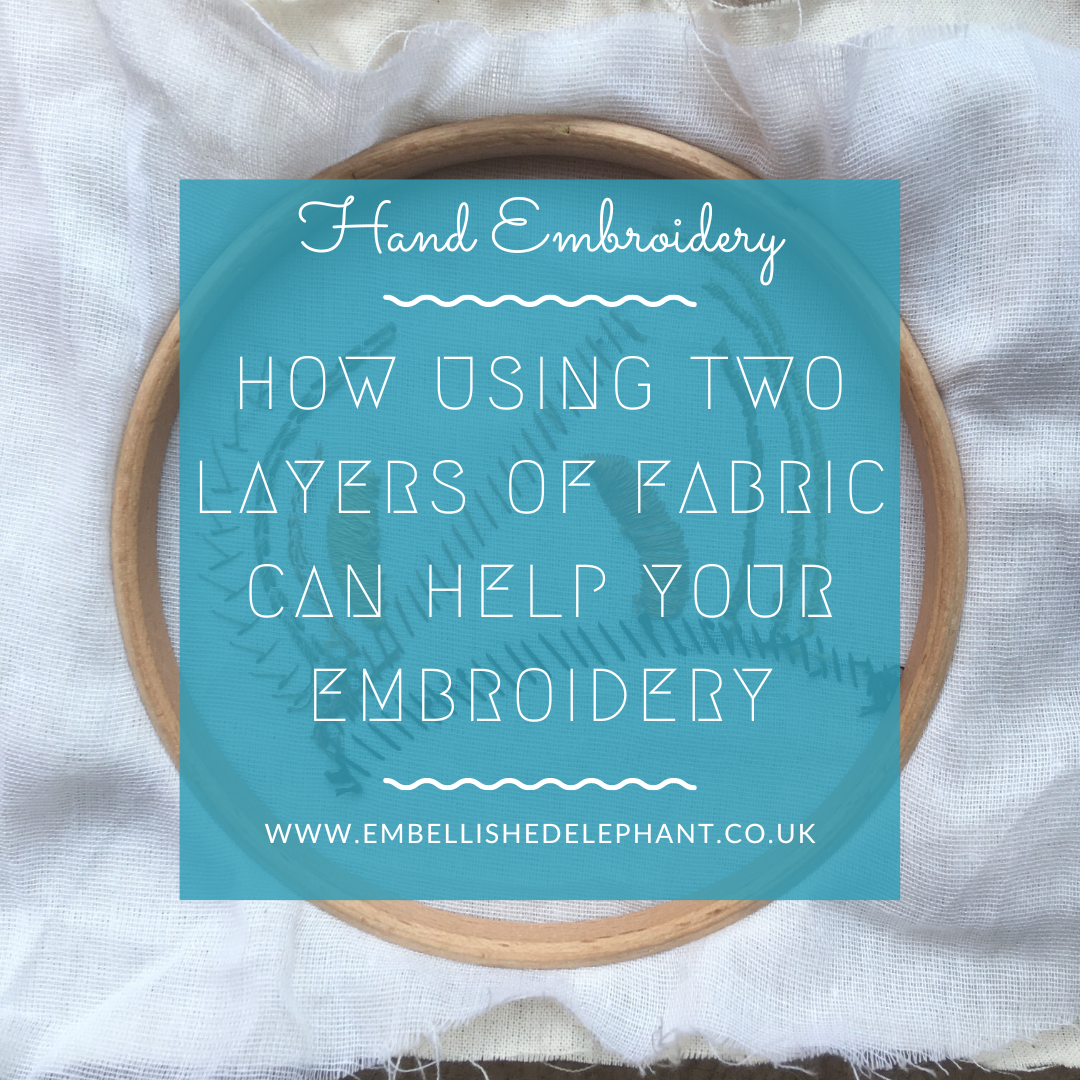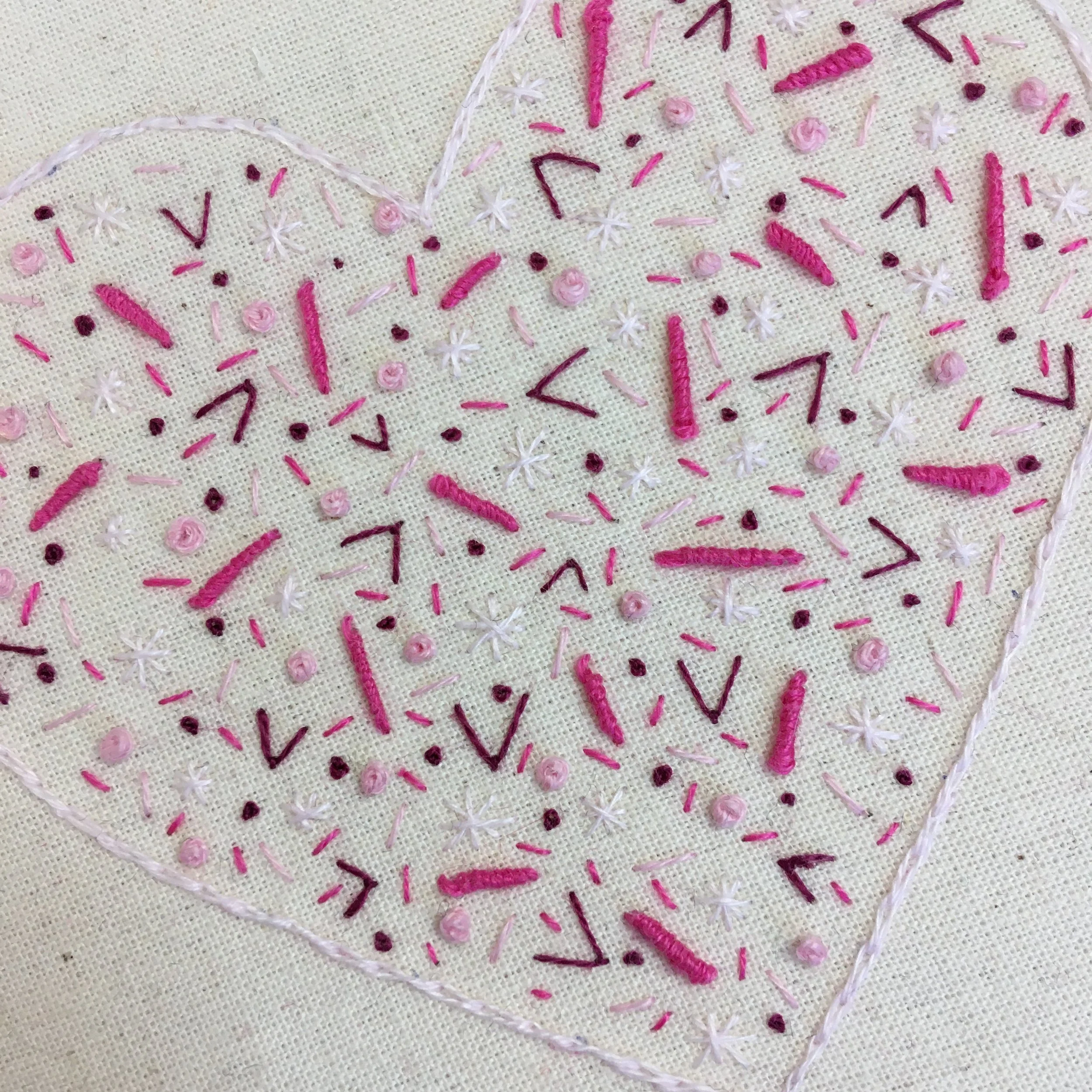
My go to fabric for embroidery is a nice bit of calico. It has a nice thread count and weight to it meaning it doesn’t pucker very much when stitching.
When I change things up and use a different type of fabric especially thinner cotton or satin fabric I’ll add in another layer (normally after I’ve stitched a few stitches and discovered that they aren’t behaving quite the way I was expecting).
But when might using two layers of fabric be useful.

Fabric not being held tight by the hoop
Sometimes you’ll have a hoop where you’ve tightened the screw as far as it will go but your fabric is still not staying taut.
This may be that the fabric is thin or slippery, or it could be that the inner and outer hoops are slightly misaligned and not as close fitting as in other hoops (such as the one pictured)
If you don’t have another hoop you can use instead, then adding another layer of fabric means that there is just a little bit more for the hoop to grip onto.

Using thicker threads and/or embellishments
Although it may not seem like it when you are stitching, each stitch adds some weight to the fabric. The more stitches there are, the more weight and the more likely the fabric is to pucker.
Beads and sequins also add weight to the fabric and can lead to puckering or sagging fabric.
Adding an under-layer of fabric helps to carry some of that weight. If you are using particularly heavy threads or embellishments then you may want to use a thicker under-layer or even add a third layer of fabric or use interfacing.
This piece had several different cords couched on the front meaning a bit of extra support was needed at the back.

Using lots of isolated stitches
There are some designs such as this kit where there are lots of stitches isolated from one another. When stitching a piece like this you could start and tie of a thread after stitching each individual but that ends up being a hassle. The easier thing is to stitch each colour in one go but you end up with thread trails between each stitch which can show on the front of the fabric.
Adding a second layer of fabric helps to hide these thread trails and make it less likely that they can be seen from the front of the fabric.
And if you do use a second layer of fabric what can you use? I tend to use a bit of muslin or a thinner weight calico but you could use any woven fabric.
Enjoyed this blog post? I share embroidery tips and a free embroidery pattern in my monthly newsletter. Sign up here to receive the newsletter on the 1st of each the month.
I'm an embroidery enthusiast with years of hands-on experience, and my expertise extends across various fabric types, stitching techniques, and embroidery challenges. This knowledge has been honed through countless projects, experimentation with different materials, and a deep understanding of the intricacies involved in achieving high-quality embroidery.
In the article you provided, the author discusses the choice of fabric for embroidery and the strategic use of multiple layers. Let's break down the key concepts used in the article:
-
Choice of Fabric:
- The author recommends calico as their go-to fabric for embroidery. Calico is favored for its desirable thread count and weight, which helps prevent puckering during stitching.
- When working with thinner cotton or satin fabrics, the author suggests adding another layer to address potential issues with fabric behavior.
-
Using Two Layers of Fabric:
- Fabric Tension: If the fabric is not held tightly in the hoop despite maximum screw tightening, an additional layer of fabric can provide more surface for the hoop to grip onto, especially when dealing with thin or slippery fabrics or misaligned hoops.
- Weight Management: The weight added by stitches, beads, and sequins can lead to fabric puckering. Adding an under-layer of fabric helps distribute and support the added weight, preventing puckering or sagging.
-
Thicker Threads and Embellishments:
- Thicker threads and heavy embellishments increase the weight on the fabric. The article suggests using a thicker under-layer or even adding a third layer of fabric or interfacing to provide extra support.
-
Isolated Stitches:
- In designs with isolated stitches, stitching each color in one go can result in visible thread trails between stitches. Adding a second layer of fabric, such as muslin or thinner weight calico, helps hide these thread trails and reduces their visibility on the front of the fabric.
The author emphasizes the practical aspects of using two layers of fabric, providing solutions for issues related to fabric tension, weight management, and the aesthetics of isolated stitches. This demonstrates a nuanced understanding of embroidery challenges and effective problem-solving techniques.